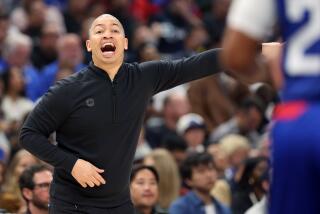The L.A. Clippers Have a Winner in the Broadcast Booth : Broadcasting: Ralph Lawler says there are advantages to announcing for a hapless team.
- Share via
Ralph Lawler has every reason to complain about his job.
As the radio and television announcer for the Clippers for 11 of the past 12 seasons, he has worked for a team that not only has had merely one winning season during that stretch but also has endured an almost unfathomable series of injuries to its top players.
But the Clippers’ futility has not taken its toll on Lawler.
“This is the best job in the world,” Lawler said. “Professional basketball is the best sport bar none, and I’ve gotten to see every great player in the league since the 1970s.”
Lawler, 51, believes that there are advantages to announcing for a hapless team.
“A broadcast is a lot more challenging when a team loses by a lot,” Lawler said. “I’ve often felt the best job I’ve done is when we’ve lost by 30 points. That’s a real challenge. A close game is simple because all the drama is there, and you don’t have to create it yourself.”
After beginning his career in Riverside, Lawler’s first announcing position with a professional team came with the San Diego Chargers in the early 1970s. From there, it was on to Philadelphia, where his assignments included play-by-play for the Phillies, 76ers and Flyers.
He joined the Clippers when they moved to San Diego in 1978. When the the team headed to Los Angeles in 1984, Lawler stayed behind, managing a real estate office, but rejoined the organization in 1985.
“I liked San Diego and was really settled there,” he said. “The move of the franchise was a shock to those of us who were part of the program in San Diego, but looking back, I should have come up the first year.”
Employed by a team whose only constant outside of losing is change, Lawler is the Clippers’ senior employee and has maintained his optimism throughout his tenure.
“There’s never been a period when I thought it was hopeless,” Lawler said. “Our first three years in San Diego, we were in the playoff chase until the final week, so those were exciting years.
“During the early years in Los Angeles, there were so many marquee names--Marques Johnson, Norm Nixon and Derek Smith. Going into each season, I thought, ‘This is the year it’s going to start to turn around,’ but a staggering amount of injuries stopped us year by year.”
This season was no different. Everything seemingly fell into place when shooting guard Ron Harper was acquired from the Cleveland Cavaliers Nov. 16. In early January, his play sparked the Clippers to a 5-3 road trip, the best in the team’s West Coast history. When the team returned Jan. 16, Lawler sensed that the game against the Charlotte Hornets was the franchise’s high point.
That night, 10,120 fans came to the Sports Arena to welcome back the Clippers. The media, which usually ignores the Clippers in favor of the Lakers across town, were also out in full force, with CBS and ESPN present to produce features on what had become the NBA’s surprise team.
“The feeling in the building was electric,” Lawler recalled. “All that hard work everyone’s put in. All those miserable nights. All those 30-point losses. All that waiting for the young players to mature--that night, by God, here it is. A nice home stand was lying ahead. It was a nice taking-off point. It turned out not to be.”
With 7:04 to play, Harper, who had scored a game-high 33 points, had his leg buckle after catching a pass from point guard Gary Grant. A day later, he was diagnosed as having a torn anterior cruciate ligament with torn cartilage in his right knee. He was out for the rest of the season.
Less than three weeks later, the Clippers were again hit by a season-ending injury, when Grant fractured his left ankle.
Since Harper’s injury, the Clippers have lost 24 of 34 games and are destined for another losing, non-playoff season. One thing the injuries have done is change the way people think about the team, Lawler said.
“I sense a sympathy that’s very prevalent,” Lawler said. “It’s a lot better than it was a couple of years ago when everyone was thinking what dummies the Clippers are. I think it will go from sympathy to real fanaticism when this club gets a chance to play as it was.”
Lawler takes to the airwaves tonight for a 7:30 KRLA-AM (1110) broadcast, with the expansion Minnesota Timberwolves providing the opposition. Lawler’s next KTLA Channel 5 telecast will be an April 10 game against the Dallas Mavericks.
In past seasons when the Clippers were on TV, Lawler would leave the radio booth to do a separate broadcast for television. But this season, the Clippers’ televised games are being simulcast on radio. Lawler was quick to draw a difference between the Clippers’ and Lakers’ simulcasts.
“The Lakers do a radio broadcast on television,” Lawler said. “We do a television broadcast on radio. If you’re going to do a simulcast, it makes sense to favor the television side because that’s where more fans are going to be tuned.”
He feels this approach avoids stating the obvious to the TV viewer.
“Television is the color man’s medium, and this way, the color man (Kevin Loughery for the Clippers) has a stage where he can work. Radio is really a play-by-play man’s medium because so much description has to go into it.”
More to Read
Go beyond the scoreboard
Get the latest on L.A.'s teams in the daily Sports Report newsletter.
You may occasionally receive promotional content from the Los Angeles Times.






